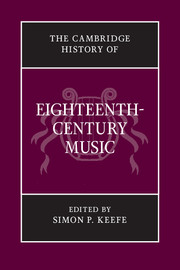Book contents
- Frontmatter
- PRELUDE
- PART I MUSIC FOR THE CHURCH
- INTERLUDE
- PART II MUSIC FOR THE THEATRE
- INTERLUDE
- PART III MUSIC FOR THE SALON AND CONCERT ROOM
- 16 Keyboard music from Couperin to early Beethoven
- 17 The serenata in the eighteenth century
- 18 Private music in public spheres: chamber cantata and song
- 19 Handel and English oratorio
- 20 The overture-suite, concerto grosso, ripieno concerto and Harmoniemusik in the eighteenth century
- 21 Concerto of the individual
- 22 Eighteenth-century symphonies: an unfinished dialogue
- 23 The string quartet
- POSTLUDE
- Appendix I Chronology
- Appendix II Institutions in major European cities
- Appendix III Personalia
- Index
- References
20 - The overture-suite, concerto grosso, ripieno concerto and Harmoniemusik in the eighteenth century
from PART III - MUSIC FOR THE SALON AND CONCERT ROOM
Published online by Cambridge University Press: 28 March 2011
- Frontmatter
- PRELUDE
- PART I MUSIC FOR THE CHURCH
- INTERLUDE
- PART II MUSIC FOR THE THEATRE
- INTERLUDE
- PART III MUSIC FOR THE SALON AND CONCERT ROOM
- 16 Keyboard music from Couperin to early Beethoven
- 17 The serenata in the eighteenth century
- 18 Private music in public spheres: chamber cantata and song
- 19 Handel and English oratorio
- 20 The overture-suite, concerto grosso, ripieno concerto and Harmoniemusik in the eighteenth century
- 21 Concerto of the individual
- 22 Eighteenth-century symphonies: an unfinished dialogue
- 23 The string quartet
- POSTLUDE
- Appendix I Chronology
- Appendix II Institutions in major European cities
- Appendix III Personalia
- Index
- References
Summary
Historical narratives of eighteenth-century orchestral music have, with good reason, tended to focus on the ascendancy of the solo concerto and the emergence – and eventual dominance – of the concert symphony. Likewise, instrumental chamber music of the second half of the century has been viewed largely from the perspective of the new string quartet and duo or trio with obbligato keyboard. We need hardly point out that all these types remained of central importance during the nineteenth and twentieth centuries. Often lost in the historiographical shuffle, by contrast, are genres that were equally present in the day-to-day lives of many eighteenth-century musicians and listeners, but which were nonetheless comparatively short-lived: the overture-suite, the post-Corellian concerto grosso, the ripieno concerto (or concerto for strings without soloists) and Harmoniemusik for wind band. Besides the lack of continuity between historical eras, there is the fact that few examples of these genres have achieved sustained and widespread popularity. Bach’s four overture-suites, Handel’s Water Music, Music for the Royal Fireworks and Twelve Grand Concertos, Op. 6, and Mozart’s ‘Gran Partita’ immediately come to mind. These are the works most likely to be included in pedagogical anthologies; when absent, students may be left with the mistaken impression that after 1700 suites were restricted to French keyboard works, concertos were invariably of the solo (Vivaldian) type and music for wind band was virtually unknown.
- Type
- Chapter
- Information
- The Cambridge History of Eighteenth-Century Music , pp. 556 - 582Publisher: Cambridge University PressPrint publication year: 2009



